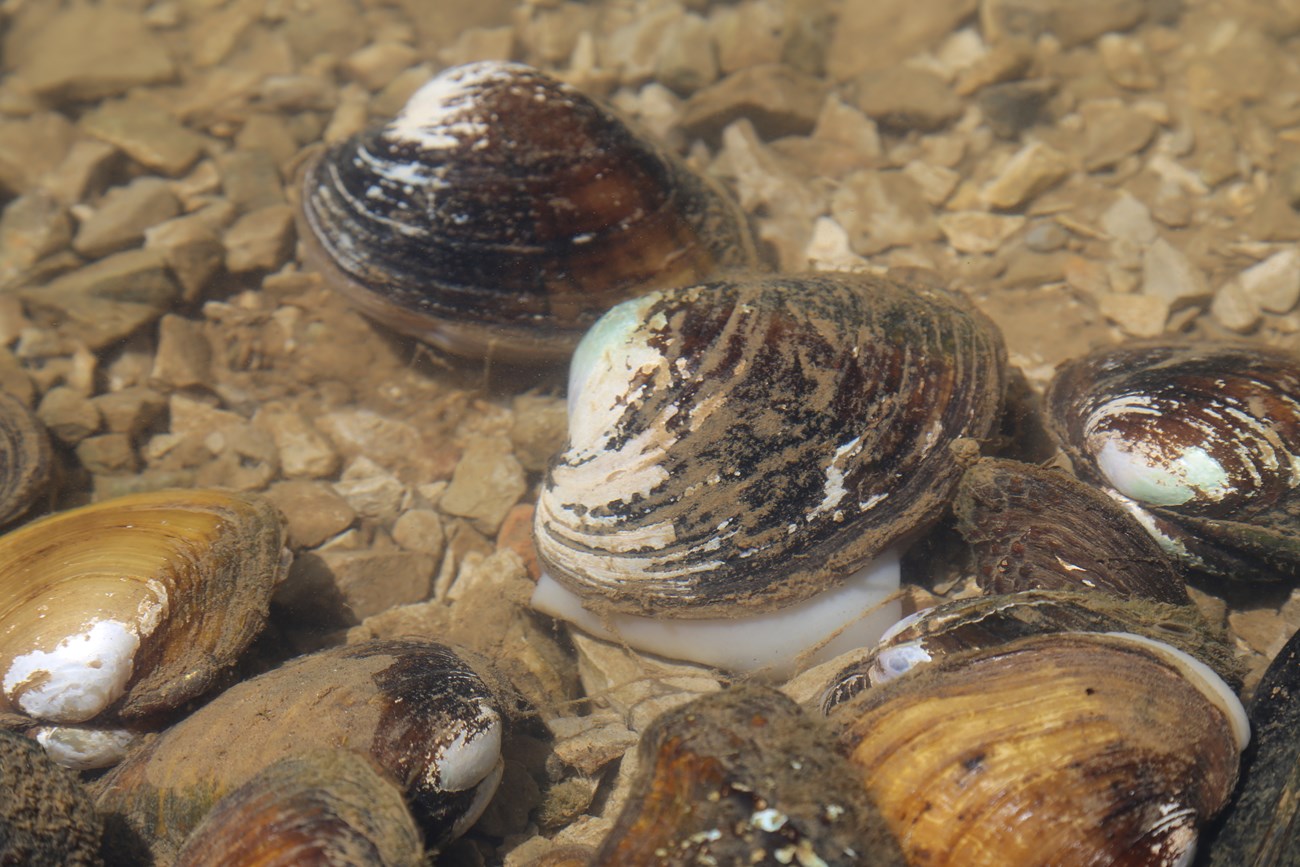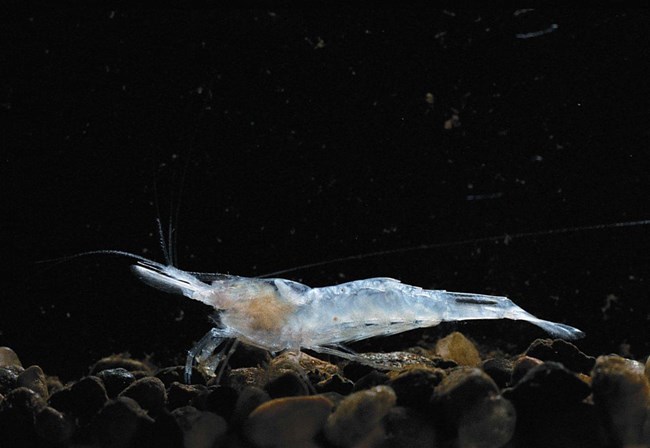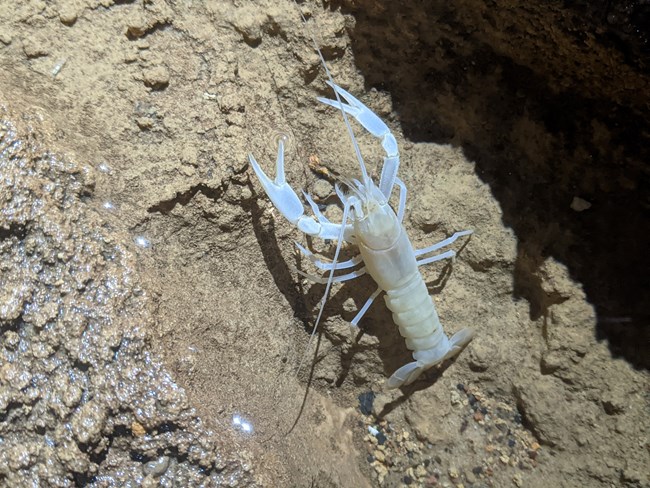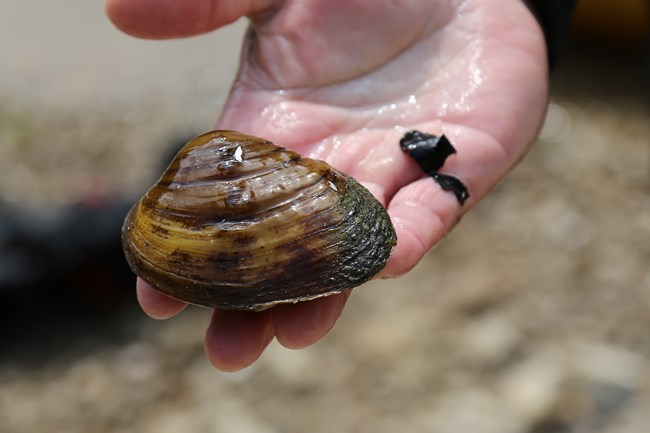
NPS Photo Crustacean and mollusk species in the park provide essential ecosystem services that are integral to the health of freshwater environments. Of these aquatic species, some common crustaceans include crayfish and shrimp, and some common mollusks include mussels, clams, and snails. 
USFWS Photo CrustaceansThe many species of crustaceans that call Mammoth Cave National Park their home are truly one of a kind. The Kentucky cave shrimp, and the Mammoth Cave crayfish can be found inhabiting the watery depths of the cave system. The most widespread crayfish species in Kentucky (Cambarus tenebrosus) calls the Green River its home. Kentucky cave shrimp Palaemonias ganteriThe endangered Kentucky cave shrimp is found nowhere on Earth except for in the large, base level cave streams that flow through Mammoth Cave. They prefer streams with a slow flow, plenty of organic material, and with coarse, sandy bottoms. These tiny crustaceans will eat algal cells, fungi, and protozoans that are washed in by floodwaters. They are troglobites, spending their entire life cycle in the cave. 
NPS Photo/ Anya Gupta Mammoth Cave crayfish Orconectes pellucidusThis crayfish is a troglophile, meaning they prefer to spend their time in the cave but will travel aboveground if necessary. They are able to move over land to different pools and streams in order to find food, mates, or to avoid predators. Normally found in cave streams, these crayfish typically hide under rocks or in sediment and can be seen scurrying across the rocky and sandy bottoms of stream beds. They have no eyes and no pigmentation, which is an evolutionary adaptation that allows them to conserve energy and survive in an environment with total darkness. They depend on the surface water runoff for food and nutrients, while bat guano and cricket droppings also provide sustenance for subterranean life. They lay eggs and are sensitive to environmental changes on the surface, like pollution, which may alter groundwater quality. Freshwater crayfish Cambarus tenebrosusThe most widespread crayfish species in Kentucky, they live in areas with permanent surface streams, preferring muddy river bottoms They can grow to be about 2-6 inches, and have a largely plant-based diet. They are essential to maintaining freshwater food webs and water quality by eating algae. MollusksMostly buried deep in the mud or hidden amongst the rocks, mussels, a type of mollusk, are a rare sight here at Mammoth Cave National Park. As filter feeding powerhouses, they constantly filter sediments and nutrients from the water, help sequester heavy metals, and remove pharmaceutical waste and bacteria like E. coli. This helps to keep the visibility of the water high, making it easier for other organisms to find food. Mussel beds also help create habitat for other species, while empty mussel shells provide shelter for fish, snails, and crayfish. 
NPS Photo Sheepnose mussel Plethobasus cyphyusThese mussels can grow to be about 5 inches in length, they are usually found in the shallows of wide rivers such as the Mississippi River or the Ohio River. Like many freshwater mussels, sheepnose mussels have a complex reproduction cycle in which at the larvae stage they must attach to a fish’s gills or fins. Within a few weeks the larvae become juveniles and detach to sink to the river bottom, having used the fish as a host to transport them up or downstream. For this reason, these federally endangered mussels are especially vulnerable to the effects of dams. Rayed bean mussel Villosa fabalisPreviously found in the area, the rayed bean mussel is now locally extinct in Virginia, Illinois, and Kentucky. These small mussels are often brown or a yellowish-green in color and grow to around 1.5 inches in length. They usually prefer smaller streams and headwaters and are still present in several Midwest and North-Eastern states as well as Ontario, Canada. Rayed bean mussels have been successfully reintroduced to streams in Tennessee and West Virginia. 
NPS Photo/ Anya Gupta SnailsSnails are gastropods, which literally translates to “stomach foot”. Thousands of gastropod shells are preserved in the limestone that contains Mammoth Cave, dating back to the Ordovician Era over 480 million years ago, when ancient aquatic snails inhabited the region. |
Last updated: November 18, 2021
